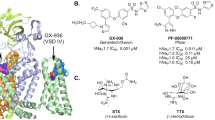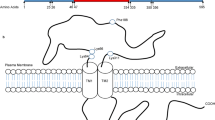Abstract
The voltage-gated Na+ channel subtype Nav1.7 is important for pain and itch in rodents and humans. We previously showed that a Nav1.7-targeting monoclonal antibody (SVmab) reduces Na+ currents and pain and itch responses in mice. Here, we investigated whether recombinant SVmab (rSVmab) binds to and blocks Nav1.7 similar to SVmab. ELISA tests revealed that SVmab was capable of binding to Nav1.7-expressing HEK293 cells, mouse DRG neurons, human nerve tissue, and the voltage-sensor domain II of Nav1.7. In contrast, rSVmab showed no or weak binding to Nav1.7 in these tests. Patch-clamp recordings showed that SVmab, but not rSVmab, markedly inhibited Na+ currents in Nav1.7-expressing HEK293 cells. Notably, electrical field stimulation increased the blocking activity of SVmab and rSVmab in Nav1.7-expressing HEK293 cells. SVmab was more effective than rSVmab in inhibiting paclitaxel-induced mechanical allodynia. SVmab also bound to human DRG neurons and inhibited their Na+ currents. Finally, potential reasons for the differential efficacy of SVmab and rSVmab and future directions are discussed.










Similar content being viewed by others
References
Catterall WA. Voltage-gated sodium channels at 60: structure, function and pathophysiology. J Physiol 2012, 590: 2577–2589.
Goldin AL. Resurgence of sodium channel research. Annu Rev Physiol 2001, 63: 871–894.
Escayg A, Goldin AL. Sodium channel SCN1A and epilepsy: mutations and mechanisms. Epilepsia 2010, 51: 1650–1658.
Jurkat-Rott K, Holzherr B, Fauler M, Lehmann-Horn F. Sodium channelopathies of skeletal muscle result from gain or loss of function. Pflugers Arch 2010, 460: 239–248.
Zimmer T, Surber R. SCN5A channelopathies—an update on mutations and mechanisms. Prog Biophys Mol Biol 2008, 98: 120–136.
Waxman SG, Dib-Hajj S, Cummins TR, Black JA. Sodium channels and pain. Proc Natl Acad Sci U S A 1999, 96: 7635–7639.
Xie W, Strong JA, Ye L, Mao JX, Zhang JM. Knockdown of sodium channel Nav1.6 blocks mechanical pain and abnormal bursting activity of afferent neurons in inflamed sensory ganglia. Pain 2013, 154: 1170–1180.
Xie W, Strong JA, Zhang JM. Early blockade of injured primary sensory afferents reduces glial cell activation in two rat neuropathic pain models. Neuroscience 2009, 160: 847–857.
Pertin M, Ji RR, Berta T, Powell AJ, Karchewski L, Tate SN, et al. Upregulation of the voltage-gated sodium channel beta2 subunit in neuropathic pain models: characterization of expression in injured and non-injured primary sensory neurons. J Neurosci 2005, 25: 10970–10980.
Pan HL, Liu BL, Lin W, Zhang YQ. Modulation of Nav1.8 by lysophosphatidic acid in the induction of bone cancer pain. Neurosci Bull 2016, 32: 445–454.
Yang Y, Huang J, Mis MA, Estacion M, Macala L, Shah P, et al. Nav1.7-A1632G Mutation from a family with inherited erythromelalgia: enhanced firing of dorsal root ganglia neurons evoked by thermal stimuli. J Neurosci 2016, 36: 7511–7522.
Cox JJ, Reimann F, Nicholas AK, Thornton G, Roberts E, Springell K, et al. An SCN9A channelopathy causes congenital inability to experience pain. Nature 2006, 444: 894–898.
Weiss J, Pyrski M, Jacobi E, Bufe B, Willnecker V, Schick B, et al. Loss-of-function mutations in sodium channel Nav1.7 cause anosmia. Nature 2011, 472: 186–190.
Drenth JP, Finley WH, Breedveld GJ, Testers L, Michiels JJ, Guillet G, et al. The primary erythermalgia-susceptibility gene is located on chromosome 2q31-32. Am J Hum Genet 2001, 68: 1277–1282.
Fertleman CR, Baker MD, Parker KA, Moffatt S, Elmslie FV, Abrahamsen B, et al. SCN9A mutations in paroxysmal extreme pain disorder: allelic variants underlie distinct channel defects and phenotypes. Neuron 2006, 52: 767–774.
Waxman SG. Painful Na-channelopathies: an expanding universe. Trends Mol Med 2013, 19: 406–409.
Bennett DL, Woods CG. Painful and painless channelopathies. Lancet Neurol 2014, 13: 587–599.
Yang L, Dong F, Yang Q, Yang PF, Wu R, Wu QF, et al. FGF13 selectively regulates heat nociception by interacting with Nav1.7. Neuron 2017, 93: 806–821 e809.
Lee JH, Park CK, Chen G, Han Q, Xie RG, Liu T, et al. A monoclonal antibody that targets a NaV1.7 channel voltage sensor for pain and itch relief. Cell 2014, 157: 1393–1404.
Laedermann CJ, Cachemaille M, Kirschmann G, Pertin M, Gosselin RD, Chang I, et al. Dysregulation of voltage-gated sodium channels by ubiquitin ligase NEDD4-2 in neuropathic pain. J Clin Invest 2013, 123: 3002–3013.
Chang W, Berta T, Kim YH, Lee S, Lee SY, Ji RR. Expression and role of voltage-gated sodium channels in human dorsal root ganglion neurons with special focus on Nav1.7, species differences, and regulation by paclitaxel. Neurosci Bull 2017. https://doi.org/10.1007/s12264-017-0132-3.
Chattopadhyay M, Mata M, Fink DJ. Continuous delta-opioid receptor activation reduces neuronal voltage-gated sodium channel (NaV1.7) levels through activation of protein kinase C in painful diabetic neuropathy. J. Neurosci 2008, 28: 6652–6658.
Jiang Y, Lee A, Chen J, Ruta V, Cadene M, Chait B, et al. X-ray structure of a voltage-dependent K+ channel. Nature 2003, 423: 33–41.
Jiang Y, Ruta V, Chen J, Lee A, MacKinnon R. The principle of gating charge movement in a voltage-dependent K+ channel. Nature 2003, 423: 42–48.
Armstrong CM, Bezanilla F. Charge movement associated with the opening and closing of the activation gates of the Na+ channels. J Gen Physiol 1974, 63: 533–552.
Cha A, Ruben PC, George AL, Jr., Fujimoto E, Bezanilla F. Voltage sensors in domains III and IV, but not I and II, are immobilized by Na+ channel fast inactivation. Neuron 1999, 22: 73–87.
Cestele S, Qu Y, Rogers JC, Rochat H, Scheuer T, Catterall WA. Voltage sensor-trapping: enhanced activation of sodium channels by beta-scorpion toxin bound to the S3–S4 loop in domain II. Neuron 1998, 21: 919–931.
Swartz KJ, MacKinnon R. Hanatoxin modifies the gating of a voltage-dependent K+ channel through multiple binding sites. Neuron 1997, 18: 665–673.
Xiao Y, Blumenthal K, Jackson JO, 2nd, Liang S, Cummins TR. The tarantula toxins ProTx-II and huwentoxin-IV differentially interact with human Nav1.7 voltage sensors to inhibit channel activation and inactivation. Mol Pharmacol 2010, 78: 1124–1134.
Liu D, Tseng M, Epstein LF, Green L, Chan B, Soriano B, et al. Evaluation of recombinant monoclonal antibody SVmab1 binding to Na V1.7 target sequences and block of human Na V1.7 currents. F1000Res 2016, 5: 2764.
Xu ZZ, Kim YH, Bang SS, Zhang Y, Berta T, Wang F, et al. Inhibition of mechanical allodynia in neuropathic pain by TLR5-mediated A-fiber blockade. Nature Medicine 2015, 21: 1326–1331.
Huang CJ, Harootunian A, Maher MP, Quan C, Raj CD, McCormack K, et al. Characterization of voltage-gated sodium-channel blockers by electrical stimulation and fluorescence detection of membrane potential. Nat Biotechnol 2006, 24: 439–446.
Wang JG, Strong JA, Xie W, Zhang JM. Local inflammation in rat dorsal root ganglion alters excitability and ion currents in small-diameter sensory neurons. Anesthesiology 2007, 107: 322–332.
Han Q, Kim YH, Wang X, Liu D, Zhang ZJ, Bey AL, et al. SHANK3 deficiency impairs heat hyperalgesia and TRPV1 signaling in primary sensory neurons. Neuron 2016, 92: 1279–1293.
Taves S, Berta T, Liu DL, Gan S, Chen G, Kim YH, et al. Spinal inhibition of p38 MAP kinase reduces inflammatory and neuropathic pain in male but not female mice: Sex-dependent microglial signaling in the spinal cord. Brain Behav Immun 2016, 55: 70–81.
Zhang MM, Wilson MJ, Azam L, Gajewiak J, Rivier JE, Bulaj G, et al. Co-expression of Na(V)beta subunits alters the kinetics of inhibition of voltage-gated sodium channels by pore-blocking mu-conotoxins. Br J Pharmacol 2013, 168: 1597–1610.
Lenkowski PW, Shah BS, Dinn AE, Lee K, Patel MK. Lidocaine block of neonatal Nav1.3 is differentially modulated by co-expression of beta1 and beta3 subunits. Eur J Pharmacol 2003, 467: 23–30.
Das S, Gilchrist J, Bosmans F, Van Petegem F. Binary architecture of the Nav1.2-beta2 signaling complex. Elife 2016, 5.
Black JA, Frezel N, Dib-Hajj SD, Waxman SG. Expression of Nav1.7 in DRG neurons extends from peripheral terminals in the skin to central preterminal branches and terminals in the dorsal horn. Mol Pain 2012, 8: 82.
Schmalhofer WA, Calhoun J, Burrows R, Bailey T, Kohler MG, Weinglass AB, et al. ProTx-II, a selective inhibitor of NaV1.7 sodium channels, blocks action potential propagation in nociceptors. Mol Pharmacol 2008, 74: 1476–1484.
Sisignano M, Baron R, Scholich K, Geisslinger G. Mechanism-based treatment for chemotherapy-induced peripheral neuropathic pain. Nat Rev Neurol 2014, 10: 694–707.
Payandeh J, Scheuer T, Zheng N, Catterall WA. The crystal structure of a voltage-gated sodium channel. Nature 2011, 475: 353–358.
Xiao Y, Jackson JO, 2nd, Liang S, Cummins TR. Common molecular determinants of tarantula huwentoxin-IV inhibition of Na+ channel voltage sensors in domains II and IV. J Biol Chem 2011, 286: 27301–27310.
Xie W, Strong JA, Zhang JM. Local knockdown of the NaV1.6 sodium channel reduces pain behaviors, sensory neuron excitability, and sympathetic sprouting in rat models of neuropathic pain. Neuroscience 2015, 291: 317–330.
Han C, Estacion M, Huang J, Vasylyev D, Zhao P, Dib-Hajj SD, et al. Human Na(v)1.8: enhanced persistent and ramp currents contribute to distinct firing properties of human DRG neurons. J Neurophysiol 2015, 113: 3172–3185.
Gold MS, Weinreich D, Kim CS, Wang R, Treanor J, Porreca F, et al. Redistribution of Na(V)1.8 in uninjured axons enables neuropathic pain. J Neurosci 2003, 23: 158–166.
Lifely MR, Hale C, Boyce S, Keen MJ, Phillips J. Glycosylation and biological activity of CAMPATH-1H expressed in different cell lines and grown under different culture conditions. Glycobiology 1995, 5: 813–822.
Higel F, Seidl A, Sorgel F, Friess W. N-glycosylation heterogeneity and the influence on structure, function and pharmacokinetics of monoclonal antibodies and Fc fusion proteins. Eur J Pharm Biopharm 2016, 100: 94–100.
Banks DD, Gadgil HS, Pipes GD, Bondarenko PV, Hobbs V, Scavezze JL, et al. Removal of cysteinylation from an unpaired sulfhydryl in the variable region of a recombinant monoclonal IgG1 antibody improves homogeneity, stability, and biological activity. J Pharm Sci 2008, 97: 775–790.
Harris RJ, Kabakoff B, Macchi FD, Shen FJ, Kwong M, Andya JD, et al. Identification of multiple sources of charge heterogeneity in a recombinant antibody. J Chromatogr B Biomed Sci Appl 2001, 752: 233–245.
Vlasak J, Bussat MC, Wang S, Wagner-Rousset E, Schaefer M, Klinguer-Hamour C, et al. Identification and characterization of asparagine deamidation in the light chain CDR1 of a humanized IgG1 antibody. Anal Biochem 2009, 392: 145–154.
Harris RJ. Heterogeneity of recombinant antibodies: linking structure to function. Dev Biol (Basel) 2005, 122: 117–127.
Du Y, Walsh A, Ehrick R, Xu W, May K, Liu H. Chromatographic analysis of the acidic and basic species of recombinant monoclonal antibodies. MAbs 2012, 4: 578–585.
Haberger M, Bomans K, Diepold K, Hook M, Gassner J, Schlothauer T, et al. Assessment of chemical modifications of sites in the CDRs of recombinant antibodies: Susceptibility vs. functionality of critical quality attributes. MAbs 2014, 6: 327–339.
McSherry T, McSherry J, Ozaeta P, Longenecker K, Ramsay C, Fishpaugh J, et al. Cysteinylation of a monoclonal antibody leads to its inactivation. MAbs 2016, 8: 718–725.
Huang L, Lu J, Wroblewski VJ, Beals JM, Riggin RM. In vivo deamidation characterization of monoclonal antibody by LC/MS/MS. Anal Chem 2005, 77: 1432–1439.
Li AL, Zhang JD, Xie W, Strong JA, Zhang JM. Inflammatory changes in paravertebral sympathetic ganglia in two rat pain models. Neurosci Bull 2017. https://doi.org/10.1007/s12264-017-0142-1.
Suter MR, Berta T, Gao YJ, Decosterd I, Ji RR. Large A-fiber activity is required for microglial proliferation and p38 MAPK activation in the spinal cord: different effects of resiniferatoxin and bupivacaine on spinal microglial changes after spared nerve injury. Mol Pain 2009, 5: 53.
Chang W. Fab fragment of Nav1.7 monoclonal antibody inhibits sodium currents in mouse and human DRG neurons and suppresses inflammatory and neuropathic pain. Abstract for Neuroscience 2016 (November 12–16, San Diego, CA 2016, Abstract Control Number: 14425.
Minett MS, Pereira V, Sikandar S, Matsuyama A, Lolignier S, Kanellopoulos AH, et al. Endogenous opioids contribute to insensitivity to pain in humans and mice lacking sodium channel Nav1.7. Nat Commun 2015, 6: 8967.
Acknowledgements
This work was supported by National Institutes of Health Grants R01NS89479, R01NS045594 and R01NS055860.
Author information
Authors and Affiliations
Corresponding authors
Rights and permissions
About this article
Cite this article
Bang, S., Yoo, J., Gong, X. et al. Differential Inhibition of Nav1.7 and Neuropathic Pain by Hybridoma-Produced and Recombinant Monoclonal Antibodies that Target Nav1.7. Neurosci. Bull. 34, 22–41 (2018). https://doi.org/10.1007/s12264-018-0203-0
Received:
Accepted:
Published:
Issue Date:
DOI: https://doi.org/10.1007/s12264-018-0203-0




